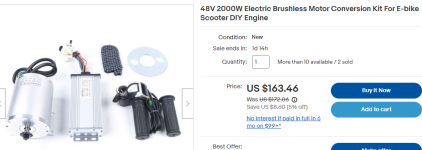My idea is to convert the mini bike to electric using a 48V 2000W Electric Brushless Motor Conversion Kit For E-bike Scooter DIY Engine from Ebay :
<snip>
That being said, I have quite a few newer 20v 4ah lithium drill batteries that I'd like to use instead of spending an additional $250 on a battery. Using this motor setup of a 48v motor, my thinking would be to run (4) batteries in series/parallel giving me what I believe should be 40v and either 8 or 16ah (this part I'm a little murky on).
Some thoughts:
Tool batteries usually use their actual max voltage as their rating, but EV stuff (and most other things) do not--they use the average voltage as their rating. So a 48v system actually charges to about 52v, and is empty about 41-42v, so the controller will probably be designed to turn itself off at that voltage.
The 20v tool batteries probably are fully charged at about that voltage; if htey are 3.7v average cells (li-ion) and about 4.2v full, they are probably 5s packs, for 5 x 4.2v = 21v full, and 5 x 3.7v = 18.5v average.
Making a pack of two of those in series is basically the same as using a 36v ebike battery, which is only about 42v full, and about 36v average.
If that's the case, then the controller will shutdown very shortly after you start using a pack like that, and will probably even shutdown just blipping the throttle even when it's full.
You'll want to get a 36v controller instead, to use those tool packs that way.
If you have four 20v 4Ah packs, wired as 2s 2p, you get 40v 8Ah. The 2s doubles the voltage, and the 2p doubles both the capacity and the current capability (max and continuous amps).
Note that if the tool packs have a BMS in them, that could fail if put in series, as they'll be designed to be used individually. If the BMS has to turn the pack off to protect the cells, it will suddenly have twice the voltage across it's FETs as it was meant to, and they could then fail. Most often they fail shorted (stuck on), in which case you won't know there has been a problem, but the pack can no longer protect itself, and can be overdischarged or overcharged, etc.
If they have no BMS there's no worry about this type of failure, but it is then even more important to use a controller with the proper current limit and LVC to protect the packs, so they don't get overstressed and/or overdischarged (which can damage them, and that has the potential to lead to a fire.
The actual power you will ever use on a golf course is likely to be pretty low on a bicycle, even a fat tire, unless you are going pretty fast, or you and the system weigh a lot and there's steep hills, or the ground under the turf is really soft, etc. I'd guess 250W to 500W is likely to be enough.
But we'll run the numbers as if the controller will at least sometimes be used at max power (for off the course, in fun rides, etc) just in case.
If you use a 48v ebike battery (since the 20v setup wont' really work for a 48v controller), then at max power, 2000w / 48v is about 42A. So you would need a 48v (13s) battery capable of at least 42A, which means either a good quality battery so you don't have to get a high-capacity battery due to the low-C-rate low-quality batteries usually have, or you need a bigger high capacity battery for the cheap ones so it can still handle the current.
If you instead get a 36V 2000w system and need that max power, then you need a battery that can do 2000w / 36v = 56A, so it will have to be even higher quality or even larger than the 48v pack for the same power capability.
If you don't need that much power, and will be doing slow speeds, flat ground, etc, then you could probably just get a 36v 500W controller to do the work, and use it with your tool batteries 2s2p.
See more below.
Looking for advice from anyone who may have done a project similar and if you think this is enough power to get through minimum of 9 holes but prefer to manage 18 holes?
That depends on how many Wh it takes for your system to go the distance. (wh/mile or wh/km)
If it's all completely flat and hard ground under the turf, and you are going very slow (walking speed) it will take very little power to travel, and it's likely you can go a long way on a small battery capacity.
If there are hills, then the total system and rider weight, and the speed you go up the hills, makes a big difference to the Wh it will take to do the work, but it will be higher usage than on flat ground.
Same for if the ground under the turf is soft, or if you are riding in any of the traps, etc.
There is a motor simulator at ebikes.ca that you can use to guesstimate power usage for a given set of conditions, to better pick the hardware you will need to do the job you want the system to do for you.




